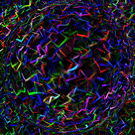So i found a post on ConvexCast, but I’m not sure how to use this properly. I am trying to use it for handling melee detection. Does convexcast help with the swiping motion, and make the ray casting more accurate?
Physics ConvexCast


Just to answer your last questions, the idea is that you can use a single convex cast to represent the attack (or whatever) rather than a series of ray casts (which are infinitely thin). Consider a baseball example - if you wanted to represent swinging the bat with raycasts you would have to use a raycasts spaced by at most the spacing of the baseball and could still miss some if you had a situation like (ball): where the colon dots are the raycasts. So it’s a combination of accuracy and performance that causes the convex cast to be preferable.

/// Perform a physics world swept convex test using a user-supplied
/// collision shape and return the first hit.
void ConvexCast(PhysicsRaycastResult& result, CollisionShape* shape,
const Vector3& startPos, const Quaternion& startRot,
const Vector3& endPos, const Quaternion& endRot,
unsigned collisionMask = M_MAX_UNSIGNED);
@GodMan Could you be more specific concerning your uncertainties?

Is the collision shape suppose to be the sword? Or does it want a bullet physics shape like the capsule or box shape?

Either will do, but keep it low-poly.

The built-in shapes are typically faster, and after that low vertex convex hulls, but if there aren’t too many of these casts happening you probably shouldn’t worry about it. I believe a capsule or box would be the fastest shape that could give you a sword-like shape, and unless you’re specifically simulating sword battles probably give you a good enough effect. You could go even further and use two objects for the casts - one is the sharp edge that cuts, the other can be a dull edge that doesn’t on a single edged sword.

void AIMelee::melee(StringHash eventType, VariantMap& eventData)
{
scene_ = node_->GetScene();
CollisionShape* shape_ = handboneNode->CreateComponent<CollisionShape>();
shape_->SetCapsule(2.0f, 2.0f, Vector3::ZERO, Quaternion::IDENTITY);
PhysicsRaycastResult raycResult;
auto* physicsWorld = scene_->GetComponent<PhysicsWorld>();
const Vector3 start = body->GetPosition();
const Vector3 end = start + (Vector3::DOWN * 100.0f);
physicsWorld->ConvexCast(raycResult, shape_, start, Quaternion::IDENTITY, end, Quaternion::IDENTITY);
}
I have this, but I have no idea what I’m doing.

You could use the “animation - timestep” as the starting transform and the bone’s current state as end transform for the swipe. Does that make sense?
Also I don’t think you’ll want to create a component every time the sword is swept, it doesn’t even have to be part of the scene. Just keep a reference somewhere. Something like:
swordShape_ = MakeShared<CollisionShape>()
I must add I never walked this path, so take these instructions with a grain of salt. Maybe someone else could provide more detailed steps.
As a side note: Appending underscores tends to be reserved for member variables, and is used for discerning them from local variables.

It’s ok, then you need the check if the cast has any result
// result.body_ is the other body of the collision
if (result.body_)
{
// check others properties of cast result
}
Thanks for the post everyone. @Modanung I though about using the animation trigger similar to the way sounds are handled for footsteps. I was not sure how to go about that. Also I will remove it from the events.
I will post back later thanks.

Is there a way to visualize what is going on, for the ConvexCast? I feel like I’m taking shots in the dark. If I could see whats going on I would probably understand this more.

DebugRenderer::AddTriangleMesh(...)
should be able to help you with that.

Okay thanks man as usual

…or maybe a cylinder will do.
DebugRenderer::AddCylinder(...)